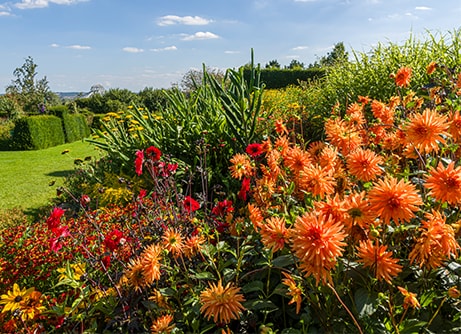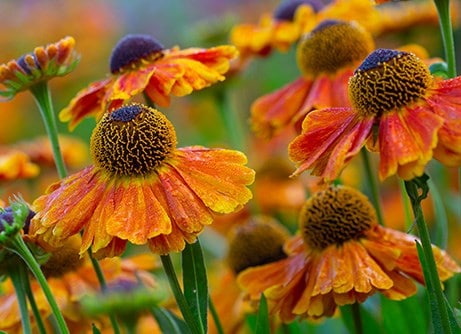
Aromatic and low-growing, this mat-forming perennial produces finely divided, feathery green foliage with a distinct apple-like scent.
Throughout summer, it is covered in small, white, daisy-like flowers with golden centres, attracting pollinators and adding charm to herb gardens, borders and pathways. Thriving in full sun and well-drained soil, common chamomile is drought-tolerant once established and makes an excellent choice for ground cover or even a fragrant lawn alternative.
Chamaemelum nobile is widely valued for its medicinal properties, with dried flowers traditionally used for herbal tea and aromatherapy. Regular trimming helps maintain a neat appearance, while allowing some flowers to mature provides a continuous supply for harvest.
Throughout summer, it is covered in small, white, daisy-like flowers with golden centres, attracting pollinators and adding charm to herb gardens, borders and pathways. Thriving in full sun and well-drained soil, common chamomile is drought-tolerant once established and makes an excellent choice for ground cover or even a fragrant lawn alternative.
Chamaemelum nobile is widely valued for its medicinal properties, with dried flowers traditionally used for herbal tea and aromatherapy. Regular trimming helps maintain a neat appearance, while allowing some flowers to mature provides a continuous supply for harvest.
How to care for Chamaemelum nobile:
Chamomile thrives in full sun and well-drained, sandy or loamy soil, making it ideal for rock gardens, borders, and herb gardens. When planting, space plants around 20–30cm (8-12in) apart to allow them to spread and form a dense, aromatic mat.
Water deeply when the soil becomes dry rather than giving frequent light waterings, as this encourages deeper root growth and improves drought tolerance. Avoid overly rich soil, as this can lead to leggy growth with fewer flowers.
Trim back after flowering to maintain a tidy appearance and promote fresh new foliage. If using as a lawn alternative, occasional mowing or light trimming will help keep it compact.
In colder areas, provide some winter protection with mulch, as plants may struggle in prolonged wet conditions. Divide mature plants every few years to maintain vigour and prevent overcrowding.
Water deeply when the soil becomes dry rather than giving frequent light waterings, as this encourages deeper root growth and improves drought tolerance. Avoid overly rich soil, as this can lead to leggy growth with fewer flowers.
Trim back after flowering to maintain a tidy appearance and promote fresh new foliage. If using as a lawn alternative, occasional mowing or light trimming will help keep it compact.
In colder areas, provide some winter protection with mulch, as plants may struggle in prolonged wet conditions. Divide mature plants every few years to maintain vigour and prevent overcrowding.
Sowing instructions:
Gently firm the seeds into the surface of good seed compost and thin when large enough to handle, transplanting into individual pots or planting out into a well prepared seed bed.
Alternatively sow direct into a weed-free bed that has a very fine tilth, which has been firmed and levelled. Mix the very fine seed with sand, and allowing one packet of seeds per square metre, distribute the seed. Leave uncovered and water in using a fine spray.
Do not allow the soil to dry out, but avoid excessively wet conditions. You may need to protect the area from birds as they may eat the seed.
Thin to 30cm (or 10-15cm if you want a more immediate effect), and cut back the plants to encourage bushier growth.
Alternatively sow direct into a weed-free bed that has a very fine tilth, which has been firmed and levelled. Mix the very fine seed with sand, and allowing one packet of seeds per square metre, distribute the seed. Leave uncovered and water in using a fine spray.
Do not allow the soil to dry out, but avoid excessively wet conditions. You may need to protect the area from birds as they may eat the seed.
Thin to 30cm (or 10-15cm if you want a more immediate effect), and cut back the plants to encourage bushier growth.
Flowering period:
- Jan
- Feb
- Mar
- Apr
- May
- Jun
- Jul
- Aug
- Sep
- Oct
- Nov
- Dec
Eventual height:
0.3m
Eventual spread:
0.45m
Position:
Full sun
Rate of growth:
Average
Soil:
Moderately fertile, moist, well-drained soil
Hardiness:
Fully hardy
Product options

9cm pot
was £7.99
now £4.79
In stock
(shipped within 2-3 working days)
(shipped within 2-3 working days)

2 + 1 FREE 9cm pots
was £15.98
now £9.59
£3.20 each
In stock
(shipped within 2-3 working days)
(shipped within 2-3 working days)

approx 400 seeds
£2.99
In stock
(shipped within 2-3 working days)
(shipped within 2-3 working days)
1
Delivery options (pick your preferred option at checkout)
Standard Delivery£5.99
Named Day Delivery£10.99









